History, prehistory and the languages of Cyprus
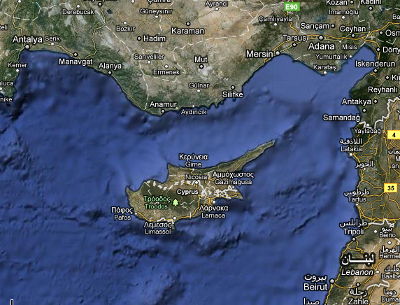 Six million years ago, the Mediterranean sea was almost completely desiccated. This event allowed dwarf elephants (Elephas cypriotes) and pony hippos to pass from Africa to the island known today as Cyprus. Those animals attracted hunters from central Anatolia (Kömürcü, Kaletepe), who became the first human inhabitants of the island, 11.000 years ago. Around 6000 B.C, people from the land known as Cilicia (the area of Southern Anatolia, enclosed by the Taurus and Amanos mountains) arrive to the island. That is the start of the prehistory of Cyprus, an island in the edge of the Mediterranean, where civilization developed in very remote times.
Six million years ago, the Mediterranean sea was almost completely desiccated. This event allowed dwarf elephants (Elephas cypriotes) and pony hippos to pass from Africa to the island known today as Cyprus. Those animals attracted hunters from central Anatolia (Kömürcü, Kaletepe), who became the first human inhabitants of the island, 11.000 years ago. Around 6000 B.C, people from the land known as Cilicia (the area of Southern Anatolia, enclosed by the Taurus and Amanos mountains) arrive to the island. That is the start of the prehistory of Cyprus, an island in the edge of the Mediterranean, where civilization developed in very remote times.
Unfortunately the pre-Greek history of the Cypriots is enigmatic, both in sense of events but also in sense of language and ethnic composition. The archeological data shows that new inhabitants were arriving constantly from Anatolia (especially from Tarsus and Mersin) until 2300 B.C. Things started to change at the end of the 3rd millennium B.C, when a period of Minoan contact start. At this point, the island goes through a rapid development and the first attestations about it and its people appear in documents.
In the the fifth year of Samsuiluma (1745 B.C), a cuneiform tablet with a list of goods was written down in the Sumerian town of Mari. Line 15 of the tablet reads:
“12 mana urudu misi alasiim uz tiilmuni”
12 mana refined copper of Alashiya and of Tilmun
Although not certain, Alashiya is what we know to be Cyprus name at this period of time and this record is the oldest one in existence. The name was probably in use by the Cypriots as well, as shown in the Amarna letters.
“Speak to the King of Egypt, my brother. Thus says the King of Alashiya, your brother”
The Amarna letters were written in cuneiform Akkadian, the language of diplomacy of that time. The King of the island apologizes to King Amenophis of Egypt for not delivering enough copper. He says that the hand of the Babylonian daemon Nergal has fallen upon his land and that the Lukki (Lycians?) have invaded, pillaging villages and killing people.
Cyprus from the 16th to the 10th century B.C
In the 16th century B.C the first pottery from the mainland of Greece arrives in Cyprus, indicating the new connections with the Mycenaean world. Between 1200 – 1050 B.C there's a continuous Mycenaean colonization of the Island. This second wave of Greek speaking populations is followed by a third wave of invaders from the Aegean, many of whom might have been Cretans, judging from the Sub-Minoan influence in ceramics, coroplastic art and religious affairs. The culture of the old indigenous stock could not be and was not in any way intended to be exterminated. Although it been for a long time resistant to foreign influences in spheres other than material culture, this is the point when the ethnic fusion gives a strong character to the Cypriot society and culture. The religious habits consist of native Cypriot, Minoan and Mycenaean elements. The fertility god wearing a horned helmet had his origins in Arcadia and was identified as Apollo Keraeatas or Apollo Alasiotas. The ingot god in hoplite armor who protect the copper-mines is the Cypriot equivalent of Hephaestus. The goddess with the raised hands and the horns of consecration have their origins in Crete. The oxen-skulls of the religious sites are a native Cypriot habit. Human sacrifice was introduced by the newcomers and is evident only in few rare occasions, since it seems not to have been a habit of the natives.At the end of this period a devastating physical phenomenon (probably earthquake) destroys many cities of Cyprus. Finally, in the 10th century B.C Phoenicians arrive at Cyprus. They establish themselves at the city of Kition, which they call Khardihadast (“The new city”).
Writing in Cyprus
In the second millennium B.C there are two closely related writing systems in Cyprus, grouped together as Cypro-Minoan. The first appeared in the 16th century B.C and is called Cypro-Minoan I. Cypro-Minoan II appeared in the 13th century B.C. Most probably the Cypro-Minoan syllabic system derived from Linear A and has approximately 80 symbols. Unlike Linear A and Linear B that record inventories, the Cypro-Minoan tablets are continuous texts. It has been suggested that they might be poems. Tablets have been found at Ugarit, which has put forward the theory that there was a Cypriot commercial colony there. There has been by no way any successful decipherment yet and there are suspicions that CM-I and CM-II might record two different languages.
At the end of the second millennium B.C, a new writing system made its appearance in Cyprus. The Cypriot syllabary as it is called, was used to record the Cypriot dialect of Greek and an unknown language called Eteo-Cypriot. Just like Linear B, it is a syllabic system, consisting of 55 symbols. The main difference is that it possesses separate graphemes for the two series of liquid consonants and it marks the final consonants e.g ni-ko-la-o-se / Νικόλαος (Nikolaos). It is generally easier to use since it offers more complete rules for both writting and reading e.g Cypriot se-pe-re-ma / σπέρμα (seed) – Linear B pe-mo (σπέρμο). The long vowels are not indicated in the script e.g e-mi/ ἠµί (to be) nor are there double consonanants. In all diphthongs, both elements are expressed separately by the corresponding syllabograms, e.g a-ne-u / άνευ (without).
The syllabary made it into the Hellenistic age, even though alphabetic texts existed since the 6th century B.C. One of the reasons the script had such a lifetime in a Greek world, is the conservatism of the Cypriots. It might be that they got attached to a writing that would bear no similarities to that of their Phoenician neighbors. The early inscriptions were usually short recording personal names. In classical times, inscriptions appear both in alphabetic and syllabic writing recording the same text.
Arcado-Cypriot
Arcado-Cypriot is the dialect recorded in the syllabic and alphabetic writings of Cyprus. Its name was given due to the obvious linguistic similarities of the Greek dialect of Cyprus and the dialect spoken in Arcadia. Both dialects are so close, that it is certain they share common origin. Another dialect that is closely related to Arcado-Cypriot is Pamphylian, a dialect spoken in the region of Pamphylia (Antalya province, Southern Turkey). The basic feature of those dialects is the use of the dative instead of genitive with certain prepositions, to convey motion away from,separation and distance. In Cypriot, glides are used, usually y and w to avoid hiatus e.g Κιyοναυς / Att. κίονας. From the classical period a nasal evolved sometimes in final position. The development of a nasal in suffixes had an impact on morphology resulting in the formation of a category of neuters in -αν, by analogy to the neuters in -ον.
Eteo-Cypriot
Eteo-Cypriot is the name given to the other language attested in the Cypriot syllabary. The prefix Eteo- is a term of convenience which was constructed by modern scholars based on Herodotus naming of the native Cretans as Eteo-Cretans, meaning true Cretans in Greek. Until the 4th century B.C it was still spoken at least in Amathus. Apart from some speculations, it is far from being understood since it has no similarities with any known language. Most probably it was the native pre-Greek/pre-Semitic language of the island. There are two bilingual documents where Eteo-Cypriot appears together with Greek, but even there, none of the words are certain in the context. Greek personal names appear in Eteo-Cypriot texts but their suffixes are alien to Greek e.g o-na-sa-ko-ra-se (Ονασαγόρας) in Greek is rendered o-na-sa-ko-ra-ni (Ονασαγόρανι) in Eteo-Cypriot. Eteo-Cypriot entries also exist within Greek syllabic texts.
Samples in Cypriot and translations
Eteo-Cypriot example 1:(2) a-ri-si-to-no-se | a-ra-to-wa-na-ka-so-ko-o-se
(3) ke-ra-k-e-re-tu-lo-se | ta-ka-na-?-?-so-ti | a-lo | ka-i-li-po-ti
The two first lines are supposed to represent the following text that is recorded in Greek
“The city of the Amathusians honor the noble Ariston, son of Aristonax”
Eteo-Cypriot example 2:
(2) a-i-lo | e-ki-ya-no-ti | ma-na ko
(3) to-u | pa-ki-mi-ra-nu | ta-na mu
(4) no-ti
Eteo-Cypriot example 3:
(2) a-pu- ? -pi () o-i-te () a-: pi?-ma | pi-na () a-so-na (?) tu-ka-i-mi-no-na
(3) a-ya?-i?-a?-?-?-ko-ti () a-: na | ta-i? () a-so-na () tu-ka-i-mi-no-na
(4) tu-mi-ra | o-i-te | i-mi- ka-ni () o-i-te | ta-ko (?) e-ne-mi-na () o-
(5) i-te | ta-ra-wo | e-ne-mi- na | se?-la?-wa-ti-ke | mu-so-ti
Greek-Cypriot syllabic example 1:
(2) to-i | ka-si-ke-ne-to-i
Transliteration
τοι | κασιγνέτοι
Timocyprus, son of Timocretes, setup [this monument] on [the grave] of [his] brother Cilicas.
Greek-Cypriot syllabic example 2:
Text is right to left
(o-na-si-me-se | la-ma-ko | i-po-sa)
Transliteration
Fired by Onasimes, son of Lamachos
ta-ma-ti-ri | ka-se | ko-ra-i | e-lo-wo-i-ko-se | po-te-si-o-se | a-ne-te-ke | i | tu-ka-i
Δάματρι | κας | κόραι | Ελλόfοικος | Ποτήσιος | ανέθηκε | ι(ν) | τύχαι
or simply translated as
Ellowoikos son of Potesios dedicated [this object] for luck, to Demeter and Kore
Gallery
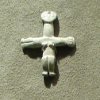

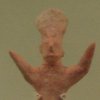
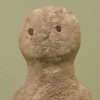
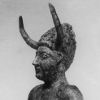
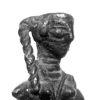
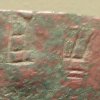
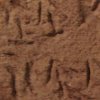
Sources
Anastasios-Phoivos Christidēs, Maria Arapopoulou, Maria Chritē, A history of ancient Greek: from the beginnings to late antiquity, Cambridge University Pres 2007
Müge Şevketoglu, Cypro-Anatolian relations in the 9th millennium, Anadolu / Anatolia 30 2006
Machteld J. Mellink, Anatolian Contacts with Chalcolithic Cyprus, Bulletin of the American Schools of Oriental Research 1991
A. R. Millard, Cypriot Copper in Babylonia, c.1745 B.C, , The American Schools of Oriental Research 1973
Annette Højen Sørensen, The Cypriot connection: aspects of Cretan contacts with Cyprus during the MB-LBI periods in A. McCarthy (ed.) Island dialogues: proceedings of the Postgraduate Cypriot Archaeology Conference (POCA), 2006, Edinburgh University Press, 2008, 154-190.